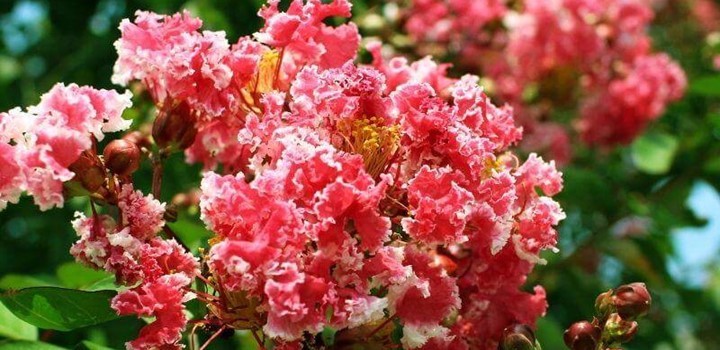If you’re like me you may be wondering what’s the best fertilizer for a Crape Myrtle. It can be a bit confusing since most fertilizers are for Crepe Myrtles. Luckily they are the same thing, and this guide will tell you which fertilizers are the best whether your call it Crape or Crepe Myrtle.
For established Crape Myrtle, a balanced or all-purpose fertilizer is okay. But during the first year, they need high nitrogen & potassium. And for blooming, try a high phosphorus container.
I know it is a bit confusing & that’s why I am here. After thorough research, finally, I am presenting to you, the 7 best fertilizers for Crape Myrtles.
Top 7 Fertilizer For Crape Myrtles- Comparisons
| Fertilizer | NPK | Form | Type | Price |
|---|---|---|---|---|
| Nelson Crape Myrtle Food | 10-15-9 | Granular | Synthetic | |
| Carl Pool Crepe Myrtle Plant Food | 8-55-7 | Granular | Synthetic | |
| Miracle-Gro Flowering Food | 18-6-12 | Granular | Semi Organic | |
| Espoma Holly Tone Fertilizer | 4-3-4 | Granular | Organic | |
| Scotts All Purpose Plant Food | 10-10-10 | Granular | Synthetic | |
| Dr. Earth Fertilizer | 3-4-3 | Granular | Organic | |
| Down To Earth Fertilizer | 4-3-6 | Granular | Organic |
Top 7 Fertilizer For Crape Myrtles- Reviews
1. Nelson Crape Myrtle & All Flowering Plant Food

Nelson Plant Food has been serving gardener’s needs since 1983. Thenceforth, the company has formulated top-quality fertilizers to feed our plants. And Nelson Crape Myrtle & all flowering Plant food is one of their masterpieces.
Nutrient Composition
The company has used ammonium phosphate, ureaform, sulfur, potassium nitrate, zinc sulfate & some other inorganic compounds to get the nutrients. And the nutrient composition is-
Primary Nutrients (needed in higher quantities): Nitrogen (10%), Phosphorus (15%), Potassium (9%),
Secondary Nutrients (needed in moderate quantities): Magnesium (2%), Sulfur (9%) &
Macronutrients (needed in tiny quantities): Copper (0.05%), Iron (2.20%), Manganese (0.25%), Zinc (0.12%)
Nutrient Analysis
You see, the fertilizer displays an NPK ratio of 10-15-9. That means 100g of this fertilizer contains 10g N, 15g P & 9g K.
Now, let’s talk about Nitrogen. You know, Crape Myrtles require high Nitrogen, especially the tree cultivars like Muskogee, Natchez, Fantasy, Fauriei, etc. & for your concern, 10% N is pretty high. Moreover, there are five sources of N that provide 7.6% slow-releasing N for long-time feeding of Crape Myrtles.
In like manner, the fertilizer supplies a high amount of phosphorus to ensure ample Crape Myrtle blooms.
Exclusive Highlights
Though this fertilizer is ideal plant food for Crape Myrtles, it is well-received for Crab Apple, Crape Myrtle, Desert willow, Flowering Pear, Mexican Plum, Mimosa, Orchid, Texas Mountain Laurel, Viburnum & Vitex.
However, the most exclusive part is, it is a NUTRISTAR product. Nutristar is the Formula of Nelson Plant Food which guarantees improved blooming & stem strength. Additionally, it contains biosolids to enhance the soil quality organically.
Applying Method
For an inground single trunk Crape Myrtle tree of more than 12′ height, dig 1″ diameter holes of 6-12″ deep following the dripline. The distance between two holes should be 24″. Now, distribute 3 cups of the fertilizer evenly into the holes & water thoroughly.
2. Carl Pool Crepe Myrtle Plant Food

Carl Pool Crape Myrtle Plant food has an Amazon Best Seller tag. And that tells us, this fertilizer is a leading preference of gardeners for Crape Myrtle’s fertilization. Let’s see why it is so well accepted-
Nutrient Composition
Though all the nutrients are obtained from safe inorganic sources, the nutrient composition is undeniably majestic for any flowering plant. The NPK ratio is 8-55-7. Along with N, P & K, the fertilizer provides five other essential micronutrients. And those are- Mg (0.50%), Cu (0.05%), Fe (0.18%), Mn (0.05%) & Zn (0.11%).
Nutrient Analysis
You know, phosphorus actively supports the energy transfer system of plants required for flowering & fruit setting. And that reveals the reason behind the massive phosphorus content of this fertilizer.
Moreover, it is a water-soluble Plant food to feed your Crape Myrtles instantly.
Though you may have to apply it weekly, I hope that’s not a problem as long as your Crape Myrtles show plentiful blooms.
Exclusive Highlights
I know, it’s a Crape Myrtle food, but guess what? Other flowering vines, trees & shrubs of your garden won’t mind either.
Interestingly, Cu, Fe, Mn & Zn are present in the chelated form to remain available for uptake & to avoid unnecessary harmful soil reactions for Crape Myrtles.
Applying Method
It is easy to use, just like watering. Mix 1 tablespoon of the fertilizer with 1 gallon of water & spray liberally over your potted dwarf Crape Myrtles, bushes, or trees. And to mention, one application remains effective for 7-10 days.
3. Miracle-Gro Shake ‘N Feed Flowering Trees & Shrubs Continuous Release Plant Food
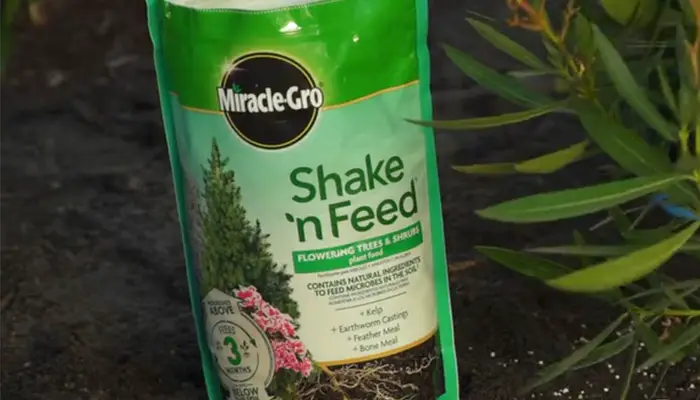
Whenever we consider buying plant foods, Miracle-Gro befalls naturally to our minds. Like all of its products, Miracle-Gro Shake ‘N feed is a very familiar name to gardeners. Why? Let’s see-
Nutrient Composition
The NPK ratio is 18-6-12. Apart from these, the fertilizer also supplies Ca (3.3%), S (6.9%), Fe (2.0%) & Mn (1.0%).
Interestingly, all these nutrients are taken from both organic & inorganic sources, such as polymer-coated urea, ammonium phosphate, ammonium sulfate, feather meal, kelp meal, alfalfa meal, earthworm casting, bone-meal, calcium carbonate & so on. And that’s how this unique blend makes it a semi-organic fertilizer.
Nutrient Analysis
The fertilizer provides 11% slow-release nitrogen obtained from polymer-coated urea & feather meal. And that’s why it is a continuous release fertilizer that feeds your Crape Myrtles for up to 3 months.
Its unique composition is specifically formulated for flowering trees, shrubs, and other acid-loving plants to secure deep, rich green foliage and vivid blooms throughout the season.
And additionally, the organic sources also add some other micronutrients like zinc, copper, iodine to help out your Crape Myrtles.
Exclusive Highlights
The most exclusive part is, the fertilizer includes natural components such as kelp, earthworm castings, feather meal & bone meal to feed the soil microbes. Soil microbes crackdown organic matter into nutrients that promote root strength and development that enhance water efficiency & increase flowering.
Applying Method
For in-ground Crape Myrtle trees, measure the diameter of the drip-line fast. For 4′ of diameter, apply 3 tablespoons of the fertilizer following the drip line & then water thoroughly.
4. Espoma Holly Tone Fertilizer
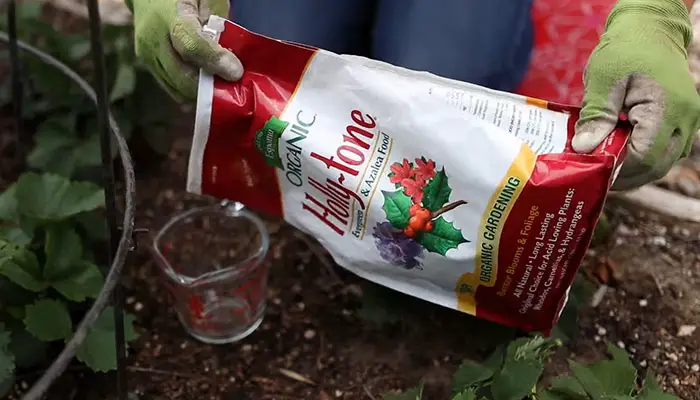
Espoma is a remarkable brand for organic gardening. Since 1929, the Espoma brand has released so many outstanding plant foods like Holly-Tone fertilizer. More details-
Nutrient Composition
Feather meal, poultry manure, bone meal, alfalfa meal, greensand, sulfate of potash, sulfate of potash magnesia & elemental sulfur- these eight organic sources have contributed nutrients to the composition. However, the nutrient composition is-
Primary Nutrients: N (4%), P (3%), K (4%) &
Secondary Nutrients: Ca (5%), Mg (1%), S (5%)
Nutrient Analysis
The fertilizer contains Nitrogen of two available forms (NH4+, NO3-) for immediate feeding & 2.5% water-insoluble nitrogen for slow release & long-term feeding.
And though the company hasn’t declared the presence of any other nutrients, my research says it also adds some micronutrients like Fe, Na, Mn, etc.
Exclusive Highlights
Espoma Holly-Tone fertilizer guarantees better blooms & foliage for acid-loving plants like Crape Myrtles, Hydrangeas, Rhodos & many more.
But the fertilizer is widely welcomed for its exclusive BIO-TONE formula- a blend of beneficial biostimulants like bacteria & mycorrhizae. It ensures fast root establishment, stress tolerance & better blooms for Crape Myrtles.
Moreover, the fertilizer also preserves 1% humic acid to improve soil quality & nutrient uptake ability of Crape Myrtles.
With all these features, it is undisputedly the best organic fertilizer for Crape Myrtles.
Applying Method
For potted Crape Myrtles, spatter 4 tablespoons of Holly-tone for each 12″ of pot diameter into the soil along the outer end of the pot. And then, water thoroughly.
5. Scotts All Purpose Flower & Vegetable Continuous Release Plant Food

Crape Myrtles bloom throughout the whole summer & definitely a continuous-release fertilizer makes it easier to stay healthy & bloom abundantly during adverse summer. So, if you are looking for an all-purpose continuous release fertilizer, here you go-
Nutrient Composition
It is a balanced fertilizer which means the NPK ratio is 10-10-10. And the nutrient sources are urea, polymer-coated sulfur-coated urea, potassium chloride & ammonium phosphate.
By the way, it also adds 2% sulfur to the soil.
Nutrient Analysis
The fertilizer supplies four very essential nutrients for crape Myrtles. If we talk about nitrogen, it is available in two forms to get uptaken easily. Moreover, 5.3% of nitrogen is slowly available for feeding for up to 2 months.
Conversely, the rest of the nitrogen & three other nutrients are released instantly for hungry Crape Myrtles.
Exclusive Highlights
All-purpose fertilizer itself is a special one. It relieves you from picking dilemmas.
Anyway, the fertilizer guarantees beautiful & abundant Crape Myrtle flowers and plenty of vegetable harvests from your garden. Moreover, the fertilizer encourages strong root growth and dense foliage.
Applying Method
For in-ground Crape Myrtles, apply evenly over the soil maintaining the ratio of a half tablespoon per 1 square foot area. Rake the top 1-3 inch soil & water thoroughly.
6. Dr. Earth Organic Acid Fertilizer
“Our purpose is simple – to make the very best products that come from the best ingredients on earth”- Dr. Earth company explains its purpose like that. Quite promising, right? Let’s match this product’s quality with its promises-
Nutrient Composition
The fertilizer obtained its nutrients from the best natural & organic sources like alfalfa meal, fishbone meal, feather meal, bone meal, potassium sulfate, kelp meal & kelp flour. And they also ensured 0% presence of filler & sludges to maintain the purity.
However, the product label says it supplies 3% N, 4% P & 3% K. But my further research says that the sources supply some other macro & micronutrients too.
Nutrient Analysis
You see, the fertilizer contains an equal amount of N & K but a higher amount of P. Well, as I said earlier, phosphorus works behind abundant blooming. So, that requirement is fulfilled. Moreover, available phosphorus feeds your Crape Myrtles immediately.
Now, Potassium also releases immediately & but all the nitrogen of this fertilizer is water-insoluble. You know, water-insoluble nutrients get available to uptake more slowly than soluble ones. And that ensures long-term nitrogen feeding for the gradual growth of your Crape Myrtles.
Exclusive Highlights
First of all, it is OMRI-approved, so good news for organic gardeners. Secondly, it contains 11% Humic acid! Can you believe it? This high humic acid content would enhance the soil structure, soil drainage & nutrient holding capacity of your Crape Myrtles.
Thirdly, TruBiotic present. So, what is TruBiotic? It is a special blend of colony-forming soil microbes & Mycorrhizae to keep the soil fertile & improve gradually.
And fourthly, along with Crape Myrtles, you can apply it for other acid-loving plants like Hollies, Gardenias, Hydrangeas, etc.
So, tell me, isn’t it the perfect natural fertilizer for Crape Myrtles?
Applying Method
For potted Crape Myrtles, sprinkle evenly two tablespoons of fertilizer per gallon of potting soil. After light working on the soil, water thoroughly.
7. Down To Earth All Natural Acid Mix Fertilizer

Apart from their premium quality fertilizers, I like the idea of using the fertilizer packet as a paper mulch for recycling purposes. Anyway, let’s talk about the All Natural Acid Mix Fertilizer-
Nutrient Composition
The fertilizer derived all its nutrients from prominent organic sources, such as cottonseed meal, fishbone meal, kelp meal, rock phosphate & langbeinite. And the nutrient composition is-
Primary Nutrients: N (4%), P (3%), K (6%) &
Secondary Nutrients: Ca (3%), Mg (2%), S (2%)
Nutrient Analysis
The fertilizer ensures both abundant blooming & vigorous growth. How? Let me explain-
0.4% of N & all other nutrients are instant releasers which means Crape Myrtle could uptake them just after applying. But 3.6% N is water-insoluble & feeds your Crape Myrtle steadily for a long time. So, if you apply the fertilizer when the growth starts & apply it again while the bud shows up, you will get both abundant blooms & vigorous growth.
Exclusive Highlights
The fertilizer is suitable for all acid-loving plants like Crape Myrtles, Hydrangeas, Rhododendrons, Blueberries, Raspberries, etc.
And additionally, it contains 2.5% humic acid to make your Crape Myrtle’s feeding easier & to raise the soil quality.
Applying Method
Provide two tablespoons of acid mix per gallon of soil to your potted Crape Myrtles. After that, provide water thoroughly and relax for at least a month.
When To Fertilize Crape Myrtles?

The fertilizing thumb rule is, feed your plants throughout the first year & once set, fertilize only while actively growing.
You know, Crape Myrtles are summer bloomers & flowers only in new growth. And this new growth starts from early spring & ends with going dormant in late fall or winter.
So, when Crape Myrtles come up with new leaves & buds in early spring, they tell you to start fertilizing.
Now you may think about how often you should fertilize your Crape Myrtles. Well, it depends on numerous factors. For instance-
Soil’s nutrient status
Your fertilizer company recommendation, etc.
But expert gardeners usually suggest fertilizing Crape Myrtles every 14 days from March to August.
How to Fertilize Crape Myrtles?
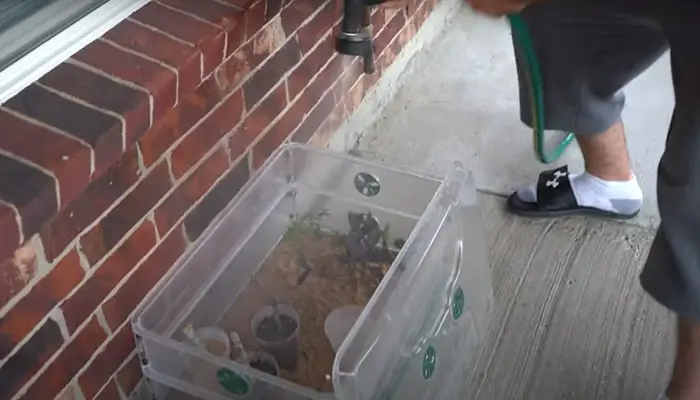
Generally, you provide fertilizer to your Crape Myrtles either in granular form or in mixed liquid form.
Granular Form
Procedure
- Prepare exact doses maintaining the packet label
- sprinkle the granules at the edges of the pot, rake the soil & water thoroughly.
- For inground trees or bushes, make 1″ diameter & 6-8″ deep holes around the drip-line. Maintain a 20-24″ distance between two holes. Now pour the granules into the hole, rake the soil & water thoroughly.
But sometimes, in both cases, fertilizer requires sprinkling over the soil thoroughly. So, check the packet label first.
Liquid Form
Procedure
- According to the product label, dilute the fertilizer with water into a watering can or sprayer.
- Follow the packet label whether to soil drench or spray. And that’s all.
How To Grow Crape Myrtle?
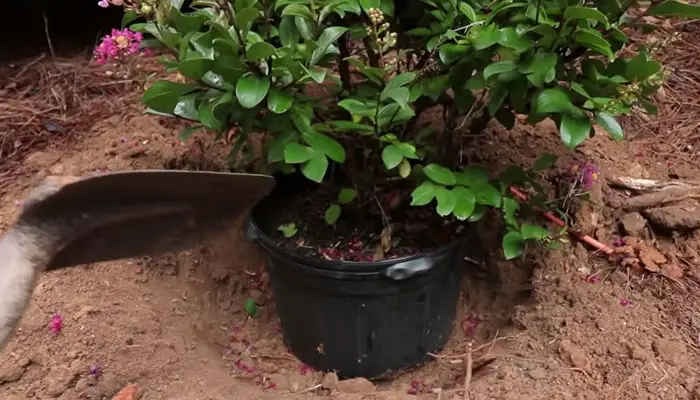
The very first action to grow Crape Myrtle is picking the specific cultivar for your garden. And some famous Crape Myrtle cultivars are Natchez, Muskogee, Tuscarora, Tonto, Balsam’s Party Pink, Acoma, Sioux, Tuskegee & many more.
However, you can decide which one to take according to your garden space, whether trees or bushes.
Once you are finished with picking, let’s plant your Crape Myrtle. Interestingly, you can plant seeds, seedlings, root cuttings, or even stem cuttings to grow Crape Myrtle. But remember, whether you plant Crape Myrtle in a pot or in-ground, well-drained loamy or sandy loam soil is the best.
Picking done, planting done. And now it’s time to take care of your Crepe Myrtle. Here are some care tips for you-
- Keep the soil moist but not soggy. The soil pH should be around 5.0-6.5
- Crape Myrtles require proper sunlight for abundant blooms. So, ensure 6-8 hours of direct sunlight.
- For recently planted Crape Myrtles, frequent watering is vital. So, keep watering accurately during the first year.
- Start fertilizing your established Crape Myrtles from early spring & keep providing throughout the entire blooming period.
- Scooty Mold, Powdery Mildew, Aphids, etc are common visitors of Crape Myrtles. So, ensure protection beforehand.
- Prune your Crape Myrtles during late winter to force new growth & abundant flowers.
How Do Make My Crape Myrtle Bloom More?

Crape Myrtles don’t bloom abundantly if they don’t get proper nutrients during their growing season. That’s why gardeners start applying fertilizers from early spring. However, here are some other tricks to get more Crape Myrtle blooms-
- Make sure your Crape Myrtles are getting proper sunlight.
- Prune them during late winter for plenty of new buds.
- Cut off bloom heads before they start producing seeds. Gardeners follow this method to get their Crape Myrtles to bloom twice a year. Interesting, right?
Frequently Asked Questions
Is Epsom Salt Good For Crape Myrtles?
Epsom Salt provides Magnesium, sulfur & oxygen. It increases the blooming of Crape Myrtles indirectly. Mix 1 tablespoon of Epsom salt with 4 liters of water & apply at the base of your Crape Myrtles to see the magic.
Are Coffee Grounds Good For Crepe Myrtles?
Crape Myrtles like coffee grounds. Coffee grounds add several nutrients to the soil & protect your Crape Myrtles from snails, worms & some other pests.
What Kind Of Soil Do Crepe Myrtles Need?
Crape Myrtles shine in loamy or sandy loam soils. But make sure that the soil is well-drained & remains moist.
Is Holly-tone Good For Crepe Myrtles?
The answer is yes. Holly-tone adds at least 10 essential nutrients to the soil. Moreover, its Biotone formula improves soil quality & adjusts soil pH for Crape Myrtles.
Are Crepe Myrtles Acid Loving?
Crape Myrtles are slightly acid-loving plants. They thrive in soil with a pH range of 5.5-6.5. And for your concern, crape Myrtles face problems to uptake nutrients if the pH range is not fixed accurately.
Conclusion
Crape Myrtles adds lushing colors to our homestead. Their presence makes a bright summer brighter. But you can’t expect the same flowering every year because nutrient levels get lower day by day.
However, I won’t lie to you. I am a choosy person & I kept researching until I got these 7 best fertilizers for Crape Myrtles.
Hopefully, my research would make your googling easy. So, pick the right one & feed your hungry Crape Myrtles.
